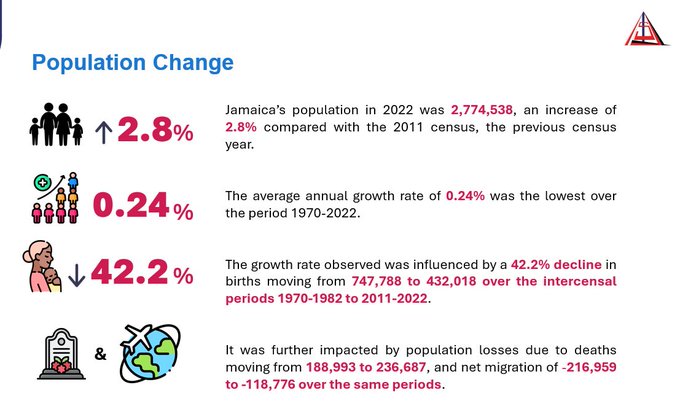Jamaica’s population reached 2,774,538 according to the 2022 Population and Housing Census, up 2.8 per cent from 2,697,983 in 2011. However, the Statistical Institute of Jamaica (STATIN) has noted that the island is experiencing its slowest population growth since 1970, driven by declining birth rates, higher deaths, and reduced net migration.
- Advertisement -
The preliminary census and geospatial findings were presented on Wednesday during STATIN’s Quarterly Press Briefing at S Hotel in Kingston.
“The equivalent average annual growth rate of 0.24 per cent for 2011 to 2022 is the lowest recorded over the period 1970 to 2022,” said STATIN Director of Censuses, Demographic and Social Statistics, Stacy-Ann Robinson. “We’re seeing where births are declining, deaths are increasing, and net migration has reduced. Together, these factors have produced slower population growth.”
The data revealed a 42.2 per cent decline in births over the past four decades, falling from 747,788 in 1970–1982 to 432,018 in 2011–2022. Meanwhile, deaths increased from 188,993 to 236,687, and net migration fell from 216,959 to 118,776 over the same period. Between 2011 and 2022 specifically, births dropped from 445,581, deaths rose from 186,516, and net migration continued its downward trend.

Despite the overall slowdown, some parishes experienced population growth, reflecting continued urbanisation. St Catherine recorded the largest increase, adding 26,545 people, followed by Clarendon with 13,540, and Kingston and St Andrew with 10,478.
“These figures highlight where the most significant population shifts have occurred, indicating areas of growth that may require increased planning and resource allocation,” Robinson said.
The census also confirmed the highest population densities in urban parishes, with Kingston and St Andrew exceeding 500 persons per square kilometre, followed by St Catherine and St James, both between 401 and 500 persons per square kilometre. In contrast, largely rural parishes such as Hanover, Westmoreland, St Elizabeth, St Thomas, Portland, St Mary, St Ann, and Trelawny recorded fewer than 200 people per square kilometre.
Robinson noted that the distribution of the population continues to shape development priorities, including housing, infrastructure, and environmental management. “The densest communities were found in St Andrew, St Catherine, and St James, along with the major urban centres and capitals. Parishes such as Portland, St Thomas, and Trelawny had some of the least densely populated communities due to their location near the Cockpit Country and the Blue Mountains,” she explained.

The 2022 census, initially scheduled for 2021, was delayed due to the COVID-19 pandemic, with data collection beginning in September 2022 and concluding in December 2024. To ensure robust population estimates, STATIN used advanced methodologies, including Global Human Settlement Population Layer modelling (GHS-POP), bottom-up modelling, and small-area population estimation techniques.
The results underscore a demographic shift towards urban centres and reveal a growing need for policy planning to address the challenges of declining birth rates, an aging population, and uneven regional population distribution.

 1 month ago
9
1 month ago
9



 English (US) ·
English (US) ·